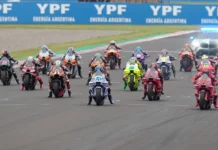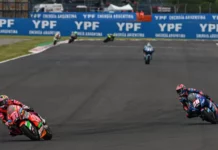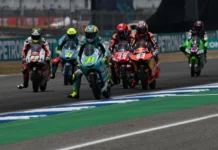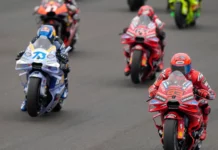(Note: This racer profile originally appeared in the September 2013 print edition of Roadracing World magazine.) No one would have blamed Kimberly Prichard if she had turned tail and ran halfway through her first race day. She got bumped twice during her very first practice session. Before she’d taken her first green flag, a crash left a racer so badly injured that he was helicoptered out. The helicopter was back for another rider just after lunch—a friend of Prichard’s, who had also crashed. But when SMRI made final call for the Open Beginner race, Prichard headed for the grid, took the green flag and a checkered flag. She did it again in the Formula Femme race. She’s been racing ever since, racking up three Championships in SMRI’s Formula Femme class and racing across the West, as well as serving as secretary of SMRI. “I just like being at the track,” says Prichard, 45, of Santa Fe, a medical laboratory scientist when not racing. Prichard started racing— and riding— later in life. “I’d always wanted to ride, but my parents wouldn’t let me, and then I got married and my now ex-husband wouldn’t let me have anything to do with them (motorcycles),” Prichard says. “So when I got divorced, I decided that I was going to do all of the things I wanted to do that other people wouldn’t let me do!” Prichard took the Motorcycle Safety Foundation course on Labor Day weekend in 2005. She rode a motorcycle for the first time in her life on that Saturday morning and went out looking for a bike that afternoon. She didn’t like the way a salesman at a local dealership treated her, so she walked out, went to the next dealership down the street and bought a Buell XB9. That was the bike Prichard did her first track day on. She loaded up the Buell with saddlebags and a backpack with supplies and rode 75 miles to NAPA Speedway near Albuquerque, New Mexico. She unloaded, prepped, rode all day, loaded back up and rode home. “It was hot, no shade, stressful—and exciting,” Prichard says. “They taught me all sorts of great things. I loved every second of it and couldn’t believe how much fun it was. I wanted to do more.” Rolling her car in the rain (someone else’s fault, she got drilled by a wayward driver) put her track-day career on pause for a bit. But when she was ready, she tried a track day on a more comfort-oriented bike—and found the vehicle lacking. So she bought a race-prepped 2003 Yamaha YZF-R6, anticipating that it would be her track-day bike. It turned out to be her first racebike—the one she rode on that eventful day in August of 2007. And once the chaos around her had settled down a bit, she loved racing every bit as much as she thought she would. “I was terrified. My mom always told me I had no common sense and I didn’t know when to be afraid,” Prichard says. “It was exciting and it was unnerving—and it was a rush. And after I completed the races, I wanted to do more. I did the Open Beginners race and the Formula Femme race, which was all women. That was very nice, because the girls were very kind! Nobody’s trying to scare you. And when one of the girls went by, she gave me a thumbs-up and I thought, ‘Now, see, this is good!’ I wanted to do more. At that point, it was, ‘How can I do more?’” Prichard raced with SMRI, ASMA, and MRA in 2008. She traveled a lot. A couple of years later, Prichard sold the YZF-R6 (Cool fact: That YZF-R6 was the first racebike for the racer who sold it to her, the first racebike for the racer she sold it to, and the first racebike for the next person who bought it). Prichard bought a Triumph 675 Daytona, which really tested her commitment to racing. “It had issues,” Prichard says. “I blew out heat exchangers every other time I rode it. It spit oil onto the tire twice and threw me down. It caused me to miss races three other times. It was trying.” (She has since sorted out the bike, and continues to race it today.) About the only good thing to come of that difficult period in 2010 was that one of the times her bike had an issue, it died before an MRA weekend started. MRA KFR (Known Fast Racer) Shane Turpin stepped up and loaned Prichard his World Superbike-spec Ducati 1098R for the women’s race. The Ducati was amazing, she said. “You’d be going down the front straight which was pretty long and I’d be hitting gears and every time I shifted the front wheel would come up. I have never had a bike float the front tire every shift,” Prichard says. Prichard loves this sport so much that sometimes she loads too much onto her plate. Ask her about the weekend in 2011, when she and three friends decided to do the four-hour endurance race with MRA in Colorado on Saturday and then drive back to Albuquerque to race with SMRI on Sunday. It would have worked out just fine—except that she highsided in the endurance race and fractured a bone in her shoulder. And scratching Sunday’s race was not an option, because by that point, she was secretary of SMRI and if she didn’t show up, there was going to be chaos. The overnight drive back to New Mexico was not something she (or any other sane human) would like to repeat. Prichard has won SMRI’s Formula Femme class three years running. She still races that class, and two or three others on a typical SMRI race day. She races with MRA at least once a year. She’s still secretary for SMRI, which causes its own set of headaches on Race Day. “I have people who won’t pit with me anymore because they can’t concentrate,” Prichard says. “I have people constantly coming up to me saying, ‘Kim, I need this, Kim, can you do this, Kim, can you fix this, Kim, can you answer this question.’ I will have people come up to me when I’m on the bike on the hot pit lane!” But supporting the sport has its own rewards. Prichard talks about giving something back, and she remembers that racer who gave her a thumbs-up on the track at the end of an incredibly difficult first day of racing. “It allows me to help people, and I enjoy that. And I get to help instruct at the track days,” Prichard says. “We’ve got racers now who I helped when they started. There are two in particular who (the club) wanted to not let come back because they were too slow and too hazardous—and I refused to let that happen. And now they’re racers. I try to round up as many girls as I can and get them involved. And I’ve gone out in a couple of Formula Femme races and played with them and let them practice passing on me. I try to pay it back—and it is fun.” Visit Kimberly Prichard’s rider profile https://www.roadracingworld.com/members/diomederacing/.
Racer Profile: Kimberly Prichard
Racer Profile: Kimberly Prichard
© 2013, Roadracing World Publishing, Inc.






